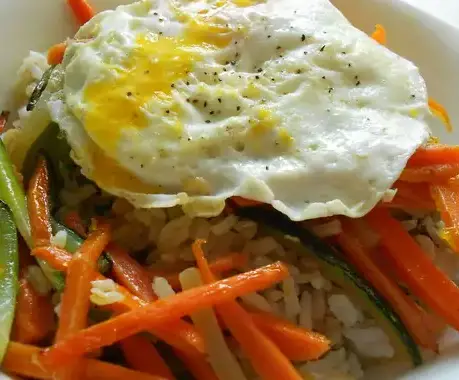Embark on a culinary adventure with our Vegetarian Bibimbap – a Korean delight that harmoniously brings together a colorful medley of vegetables, perfectly cooked rice, and a symphony of flavorful sauces. Bibimbap, which translates to “mixed rice” in Korean, is a dish that reflects the rich tapestry of Korean cuisine. In this comprehensive guide, we will delve into the ingredients, step-by-step instructions, crucial cook notes, delightful variations, and even keto and low-carb adaptations. Immerse yourself in the world of Korean flavors and elevate your dining experience with this delectable vegetarian Bibimbap.
Ingredients
Produce
- 6 oz Bamboo shoots, canned
- 1/2 (14 ounce) can Bean sprouts
- 1 cup Carrot matchsticks
- 1/3 cup Green onions
- 1 (4.5 ounce) can Mushrooms
- 1 cup Zucchini matchsticks
Refrigerated
- 3 Eggs
Condiments
- 3 tsp Red chili sauce, sweet
- 2 tbsp Soy sauce
Pasta & Grains
- 2 cups Rice, cooked and cooled
Baking & Spices
- 1/4 tsp Black pepper, ground
- 1/8 tsp Salt
Oils & Vinegars
- 2 tbsp Sesame oil
Dairy
- 1 tbsp Butter
Instructions
Step 1: Prepare the Vegetables
- Drain and rinse the canned bamboo shoots and bean sprouts.
- Sauté the bamboo shoots, bean sprouts, carrot matchsticks, green onions, mushrooms, and zucchini matchsticks separately in sesame oil until tender. Season with salt and pepper.
Step 2: Fry the Eggs
- In a pan, melt butter and fry the eggs sunny-side up. Set aside.
Step 3: Assemble the Bibimbap
- Divide the cooked rice among serving bowls.
- Arrange the sautéed vegetables and fried eggs on top of the rice.
- Drizzle soy sauce and sweet red chili sauce over the vegetables and eggs.
Step 4: Mix and Enjoy
- Encourage diners to mix the ingredients thoroughly before enjoying the burst of flavors.
Cook Notes
- Bibimbap is traditionally served in a hot stone bowl called a “dolsot,” which gives a delightful crispiness to the rice. If you have a dolsot, heat it before assembling the Bibimbap.
- Customize the level of spice by adjusting the amount of sweet red chili sauce.
Variations
Tofu Twist
- Add marinated and pan-fried tofu cubes for a protein-packed alternative.
Kimchi Kick
- Introduce the bold flavors of kimchi for a spicy and tangy Bibimbap experience.
Seaweed Sensation
- Incorporate seasoned seaweed strips for a taste of the ocean in every bite.
Keto and Low-Carb Versions
Keto
- Replace rice with cauliflower rice for a low-carb alternative.
- Use keto-friendly sweeteners in place of sugar in the sweet red chili sauce.
Low-Carb
- Opt for shirataki rice or konjac rice to significantly reduce the carb content.
- Choose low-carb vegetables like cauliflower, broccoli, and bell peppers.
Frequently Asked Questions (FAQs)
Q1: Can I make Bibimbap ahead of time?
A1: While it’s best enjoyed fresh, you can prepare the components in advance and assemble just before serving.
Q2: Is Bibimbap always vegetarian?
A2: No, traditional Bibimbap often includes meat, but this vegetarian version provides a delicious plant-based alternative.
Q3: Can I use a different type of rice?
A3: Certainly! Feel free to use brown rice, quinoa, or your preferred grain.
Q4: What is the key to a good Bibimbap?
A4: The key lies in the variety of colorful vegetables, the perfectly fried egg, and the flavorful sauce.
Q5: Can I make it gluten-free?
A5: Absolutely! Use tamari or a gluten-free soy sauce alternative in the recipe.

Vegetarian Bibimbap is not just a meal; it’s a celebration of vibrant colors, diverse textures, and the bold flavors that define Korean cuisine. As you savor each mouthful, you’ll experience the perfect harmony of vegetables, rice, and savory sauces. Whether you stick to the classic recipe or explore creative variations, Bibimbap invites you to partake in the joy of mixing and mingling flavors. Share this delightful dish with friends and family, and let the essence of Korean culinary traditions come alive in your kitchen. Elevate your dining experience with Vegetarian Bibimbap – a feast for the senses that pays homage to the beauty of simplicity and the richness of Korean gastronomy.






